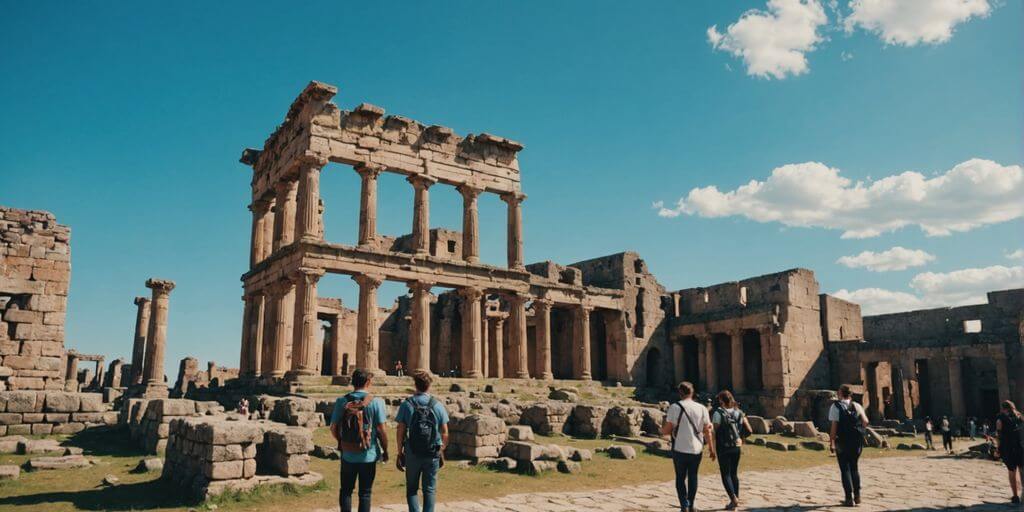Historical Travel: Exploring Ancient Ruins and Heritage Sites
Traveling to ancient ruins and heritage sites allows us to step back in time and connect with civilizations that shaped our world. These historical sites, weathered by time, hold stories of the past that are best understood through guided tours and hands-on experiences. Whether it’s the pyramids of Egypt or the temples of Southeast Asia, each site offers a unique glimpse into human history.
Key Takeaways
- Guided tours offer the best way to understand and appreciate ancient ruins.
- Many tours include opportunities for amateur archaeology, making the experience interactive.
- Iconic sites like the Pyramids of Egypt and Angkor Wat are must-visit destinations.
- UNESCO World Heritage Sites play a crucial role in preserving cultural heritage.
- Exploring these sites provides a tangible connection to the past, enriching our understanding of history.
The Allure of Ancient Ruins
Connecting with the Past
Few things are as exciting as exploring ancient ruins. From crumbling temples to well-planned cities, these structures have stood the test of time. Walking where ancient cultures once thrived is utterly enchanting. It’s like stepping into a time machine, giving us a glimpse into the lives of people who lived long ago.
The Role of Guided Tours
Guided tours can make your visit to ancient ruins even more special. A good guide can share stories and facts that you might miss on your own. They can point out hidden details and explain the significance of what you’re seeing. This makes the experience richer and more meaningful.
Amateur Archaeology Experiences
For those who want to dig a little deeper, amateur archaeology experiences are a great option. These programs let you get hands-on with history. You might help with a dig, clean artifacts, or even learn how to date ancient objects. It’s a fun way to learn and connect with the past in a very real way.
Exploring ancient ruins is like opening a window to the past. It helps us understand where we come from and appreciate the achievements of those who came before us.
Iconic Ruins of the Middle East
The Pyramids of Egypt
The Pyramids of Egypt are among the most recognizable structures in the world. These ancient marvels were built as tombs for the pharaohs and are a testament to the engineering skills of the ancient Egyptians. Standing tall in the desert, they continue to awe visitors with their grandeur and mystery.
The Mystical Ruins of Petra
Hidden away in the mountains of Jordan, Petra is a city carved into rose-red cliffs. Walking through the narrow Siq to the Treasury is like stepping into another world. The intricate facades and the sheer scale of the ruins make Petra a must-visit for any history lover.
The Ancient City of Jerash
Jerash, located in modern-day Jordan, is one of the best-preserved Roman cities in the world. Its colonnaded streets, theaters, and temples offer a glimpse into life during the Roman Empire. Exploring Jerash is like walking through a living museum, where every corner tells a story of the past.
Exploring Roman Heritage Sites
Walking through the Colosseum is like stepping back in time. This massive amphitheater, once the stage for gladiator battles and public spectacles, still stands as a testament to Roman engineering and entertainment. Imagine the roar of the crowd and the clash of swords as you explore its ancient corridors.
The Roman Forum was the heart of ancient Rome, bustling with activity. Here, you can wander through the ruins of temples, basilicas, and public spaces where Romans once gathered. It’s a place where history feels incredibly alive, and every stone has a story to tell.
Pompeii and Herculaneum offer a unique glimpse into daily life in ancient Rome. These cities were frozen in time by the eruption of Mount Vesuvius in 79 AD. Walking through their streets, you can see homes, shops, and even graffiti preserved just as they were nearly 2,000 years ago.
Visiting these sites isn’t just about seeing old buildings; it’s about connecting with the past in a way that’s both educational and deeply personal.
Unveiling the Wonders of Southeast Asia
Angkor Wat in Cambodia is the largest religious complex ever built. Wandering through its vast ruins, you can feel the history come alive. The intricate carvings and towering spires are a testament to the ingenuity of the Khmer Empire. It’s a must-see for any history buff.
Located in Indonesia, Borobudur Temple is a stunning example of Buddhist architecture. This massive structure is adorned with thousands of relief panels and Buddha statues. Climbing to the top offers a breathtaking view of the surrounding landscape, making it a perfect spot for reflection and admiration.
My Son Sanctuary in Vietnam is a cluster of abandoned and partially ruined Hindu temples. These ancient structures were constructed by the Champa kings and are now a UNESCO World Heritage Site. Exploring My Son gives you a glimpse into the spiritual and cultural life of the Champa civilization.
Marvels of Mesoamerican Civilizations
Chichen Itza
Chichen Itza is one of the most famous archaeological sites in Mexico. This ancient city was a major focal point in the northern Maya lowlands from the Late Classic through the Terminal Classic periods. The Pyramid of Kukulkan, also known as El Castillo, is the most iconic structure here. Visitors can also explore the Temple of the Warriors and the Great Ball Court, which are equally impressive.
Teotihuacan
Located just north of Mexico City, Teotihuacan was once the largest city in the Americas. It is home to the awe-inspiring Pyramid of the Sun and Pyramid of the Moon, connected by the Avenue of the Dead. The city’s origins date back to around 100 BC, and it thrived until its mysterious decline around AD 550. The reasons for its fall remain a mystery, adding to its allure.
Tikal
Tikal, situated in the heart of Guatemala, is one of the largest archaeological sites of the pre-Columbian Maya civilization. The site features towering temples and palaces, with Temple IV standing as one of the tallest pre-Columbian structures in the Americas. Walking through Tikal, you can almost feel the presence of the ancient Maya who once inhabited this grand city.
Exploring these Mesoamerican marvels offers a unique glimpse into the rich history and culture of ancient civilizations. Each site tells a story of human achievement and mystery, inviting us to uncover the secrets of the past.
European Archaeological Treasures
Stonehenge
Stonehenge is one of the most famous prehistoric monuments in the world. Located in Wiltshire, England, this mysterious stone circle has fascinated historians and tourists alike. Its purpose remains a topic of debate, with theories ranging from an ancient burial ground to a celestial calendar. Walking among these massive stones, you can’t help but feel a connection to the ancient people who built it.
The Acropolis of Athens
Perched high above the city of Athens, the Acropolis is a symbol of ancient Greek civilization. The Parthenon, its most famous structure, is a testament to the architectural and artistic achievements of the Greeks. Visitors can explore the ruins and imagine the grandeur of the ancient city. The Acropolis offers a glimpse into the past, showcasing the cultural and historical significance of Greece.
The Ruins of Pompeii
The ruins of Pompeii provide a unique snapshot of Roman life frozen in time. Buried under volcanic ash from the eruption of Mount Vesuvius in 79 AD, the city was preserved for centuries. Today, visitors can wander through the streets, homes, and public buildings, gaining insight into daily life in ancient Rome. The detailed frescoes and mosaics found in Pompeii are particularly impressive, highlighting the artistry of the time.
Exploring these European archaeological treasures is like stepping back in time. Each site offers a unique window into the past, allowing us to connect with the people and cultures that shaped our world.
The Significance of UNESCO World Heritage Sites
Cultural Preservation
UNESCO World Heritage Sites play a crucial role in preserving our global heritage. These sites are protected to maintain their outstanding universal value. This means they are important to everyone, no matter where they are from. Protecting these sites helps keep our history alive for future generations.
Global Recognition
When a site is listed as a UNESCO World Heritage Site, it gains international recognition. This can help bring attention to the site and encourage people to visit and learn about it. It also means that the site is recognized as being important to the whole world, not just the country where it is located.
Tourism and Education
World Heritage Sites often become popular tourist destinations. This can be good for the local economy, as tourists spend money on things like hotels, food, and souvenirs. It also provides a chance for people to learn about different cultures and histories. However, it’s important to manage tourism carefully to make sure it doesn’t harm the site.
Conclusion
Exploring ancient ruins and heritage sites is like stepping into a time machine. These places, though worn by time, still hold the stories and achievements of past civilizations. Guided tours can make these stories come alive, helping us understand the incredible feats of our ancestors. Whether you’re wandering through the pyramids of Egypt or the ruins of Rome, each site offers a unique glimpse into history. So, pack your bags, join a tour, and let the ancient world inspire you. The past is waiting to be discovered, and there’s no better way to learn about it than by seeing it firsthand.
Frequently Asked Questions
Why should I visit ancient ruins?
Visiting ancient ruins helps you connect with history and understand past cultures. It’s like stepping back in time and seeing how people lived long ago.
What are some famous ancient ruins to visit?
Some famous ancient ruins include the Pyramids of Egypt, the Colosseum in Rome, and Angkor Wat in Cambodia. Each site has its own unique story and history.
How can guided tours enhance my visit to historical sites?
Guided tours provide expert knowledge and insights that you might miss on your own. Guides can share interesting facts and stories, making your visit more engaging and informative.
Can I participate in amateur archaeology during my visit?
Yes, some tours offer opportunities for amateur archaeology. You can experience what it’s like to dig and discover artifacts from the past.
What is the significance of UNESCO World Heritage Sites?
UNESCO World Heritage Sites are recognized for their cultural, historical, or scientific importance. They are protected to preserve their value for future generations.
How do ancient ruins contribute to education and tourism?
Ancient ruins attract tourists and provide educational opportunities. They help people learn about history, architecture, and ancient cultures, boosting both local economies and global knowledge.














Publicar comentário